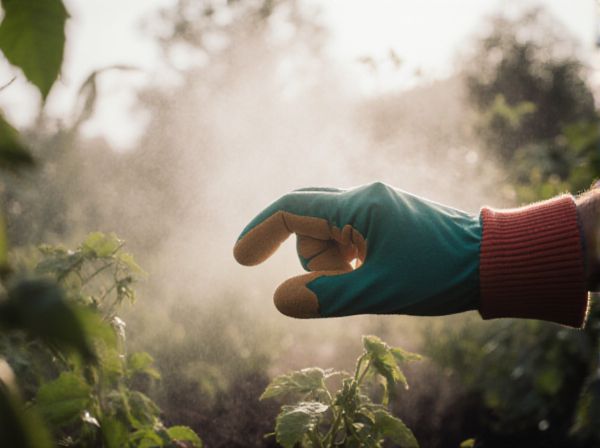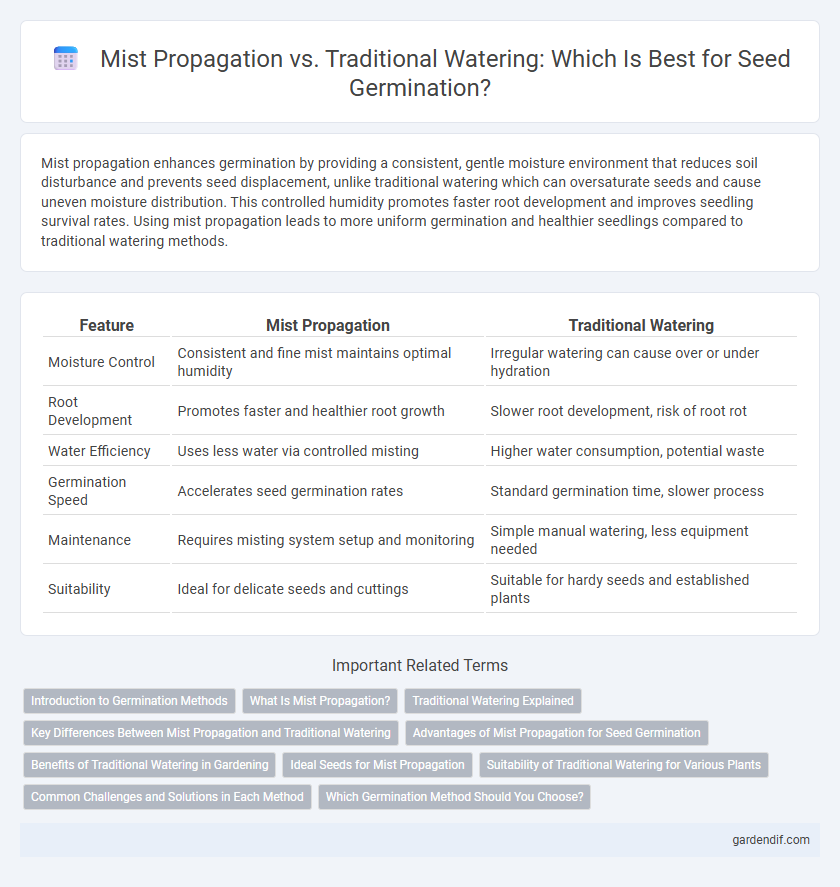
Mist propagation vs Traditional watering Illustration
Mist propagation enhances germination by providing a consistent, gentle moisture environment that reduces soil disturbance and prevents seed displacement, unlike traditional watering which can oversaturate seeds and cause uneven moisture distribution. This controlled humidity promotes faster root development and improves seedling survival rates. Using mist propagation leads to more uniform germination and healthier seedlings compared to traditional watering methods.
Table of Comparison
| Feature | Mist Propagation | Traditional Watering |
|---|---|---|
| Moisture Control | Consistent and fine mist maintains optimal humidity | Irregular watering can cause over or under hydration |
| Root Development | Promotes faster and healthier root growth | Slower root development, risk of root rot |
| Water Efficiency | Uses less water via controlled misting | Higher water consumption, potential waste |
| Germination Speed | Accelerates seed germination rates | Standard germination time, slower process |
| Maintenance | Requires misting system setup and monitoring | Simple manual watering, less equipment needed |
| Suitability | Ideal for delicate seeds and cuttings | Suitable for hardy seeds and established plants |
Introduction to Germination Methods
Mist propagation enhances germination by providing consistent moisture and humidity, which prevents seed displacement and promotes faster root development. Traditional watering often results in uneven moisture levels and soil compaction, potentially hindering seed emergence and growth. Utilizing mist propagation optimizes the microenvironment for seeds, increasing germination rates and improving seedling vigor.
What Is Mist Propagation?
Mist propagation utilizes a fine spray of water droplets to maintain consistent humidity and moisture levels around plant cuttings, encouraging root development more efficiently than traditional watering methods. This technique reduces water runoff and prevents overwatering by delivering moisture directly to the foliage and stem tissues. Unlike traditional watering, which can saturate the soil unevenly, mist propagation promotes healthier roots and faster germination by creating an optimal microenvironment for plant growth.
Traditional Watering Explained
Traditional watering for germination involves applying water directly to the soil or growing medium through methods such as hand watering, watering cans, or drip irrigation. This technique ensures consistent moisture levels critical for seed activation and root development but can sometimes lead to soil compaction or uneven water distribution. Maintaining optimal moisture without oversaturation is essential to prevent seed rot and promote successful germination.
Key Differences Between Mist Propagation and Traditional Watering
Mist propagation delivers a fine, consistent moisture mist that maintains optimal humidity around seedlings, promoting faster root development and reducing the risk of waterlogging. Traditional watering involves direct application of water, which can lead to uneven soil moisture levels and increase the chance of root rot or fungal growth. Mist propagation conserves water by minimizing runoff and evaporation, making it a more efficient method for delicate germination stages.
Advantages of Mist Propagation for Seed Germination
Mist propagation enhances seed germination by providing consistent moisture without over-saturating the soil, which prevents seed rot and fungal growth. This method maintains optimal humidity levels, promoting uniform sprout development and faster germination rates. Compared to traditional watering, mist propagation reduces water waste and minimizes soil compaction, creating ideal conditions for delicate seedling roots.
Benefits of Traditional Watering in Gardening
Traditional watering in gardening ensures consistent moisture levels, promoting strong root development and reducing the risk of fungal diseases often associated with excessive humidity from mist propagation. It allows for controlled water delivery directly to the root zone, conserving water and minimizing evaporation. This method supports healthier plant growth by maintaining optimal soil aeration and nutrient uptake.
Ideal Seeds for Mist Propagation
Mist propagation enhances germination rates for delicate seeds such as orchids, begonias, and ferns by maintaining consistent humidity and moisture levels without waterlogging. Traditional watering methods often risk over-saturation and uneven moisture distribution, which can impede seedling development. Seeds with fine, hair-like structures or those requiring high humidity environments benefit most from mist propagation, ensuring optimal sprout vigor and root establishment.
Suitability of Traditional Watering for Various Plants
Traditional watering provides consistent moisture levels suitable for a wide variety of plants, especially those with deep root systems like tomatoes and sunflowers. Unlike mist propagation, which targets delicate seedlings and humidity-loving species, traditional watering supports plants requiring thorough soil saturation to promote robust root development. This method is particularly effective for drought-tolerant plants and mature specimens that need regular but controlled hydration to thrive.
Common Challenges and Solutions in Each Method
Mist propagation often faces challenges such as inconsistent moisture levels leading to fungal growth, while traditional watering can cause soil compaction and uneven hydration. Solutions for mist propagation include regulating mist intervals and ensuring proper airflow to prevent mold, whereas traditional watering benefits from using drip irrigation and well-draining media to maintain balanced moisture. Both methods require careful monitoring of humidity and root conditions to optimize seedling germination success.
Which Germination Method Should You Choose?
Mist propagation ensures a consistently moist environment ideal for seed germination, reducing the risk of fungal infections common with traditional watering. Traditional watering can sometimes oversaturate soil, leading to poor oxygen flow and delayed sprout development. Choosing mist propagation often results in faster, more uniform germination and higher seedling survival rates.
Mist propagation vs Traditional watering Infographic

 gardendif.com
gardendif.com